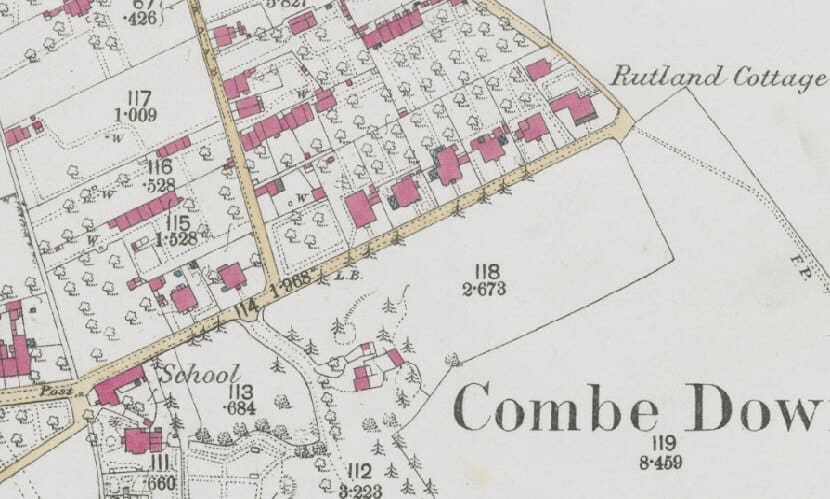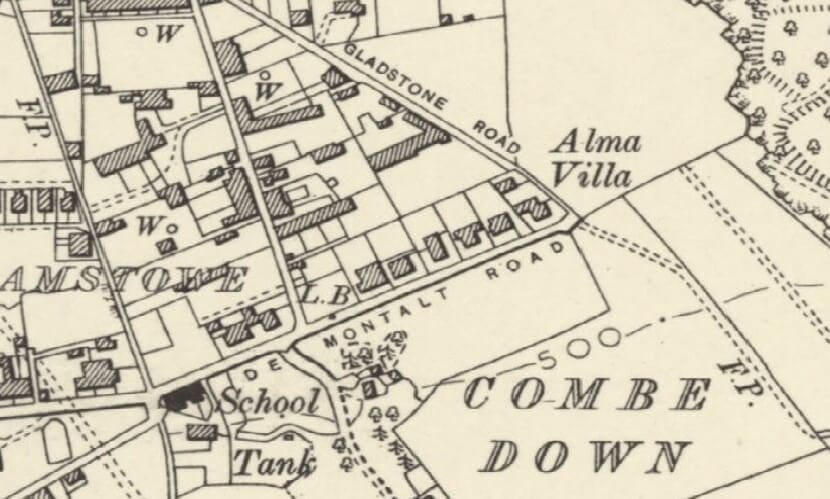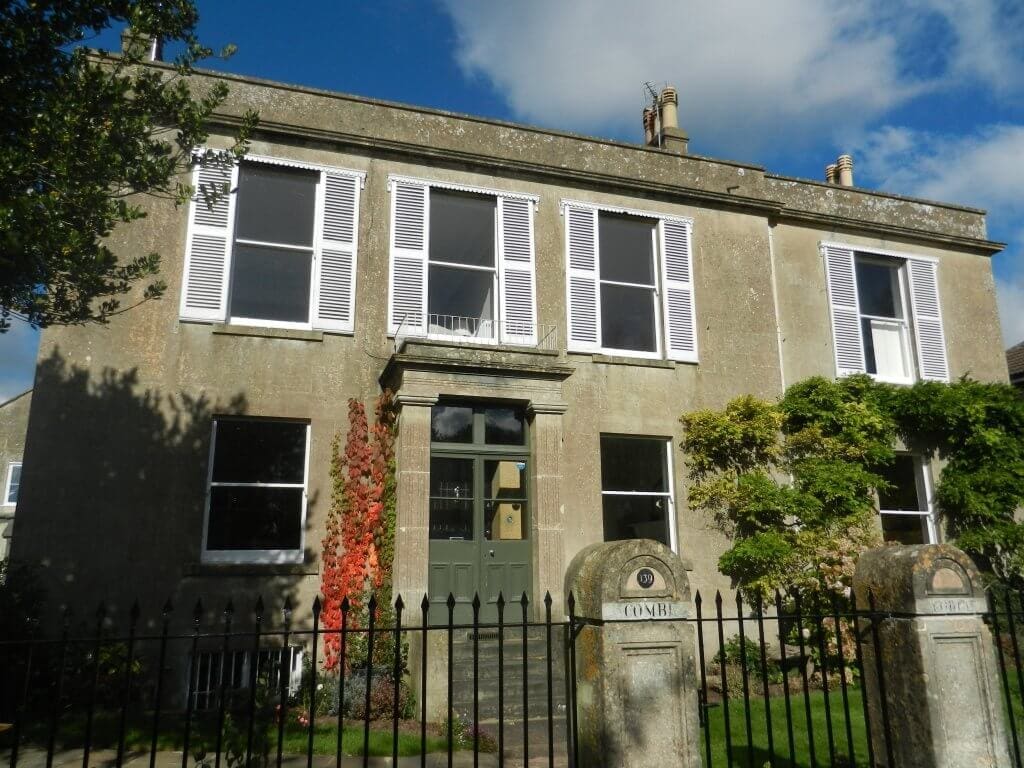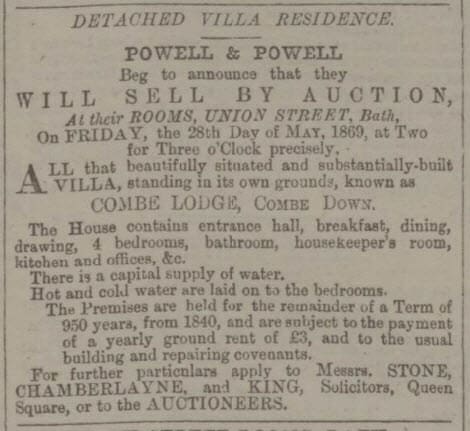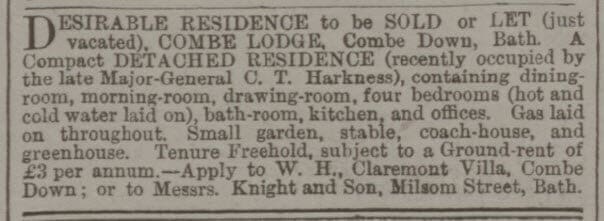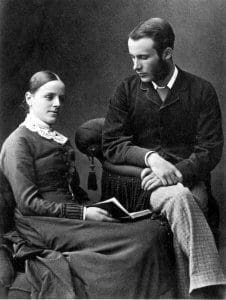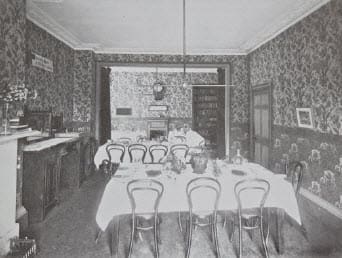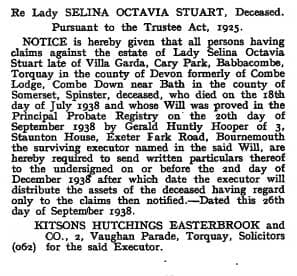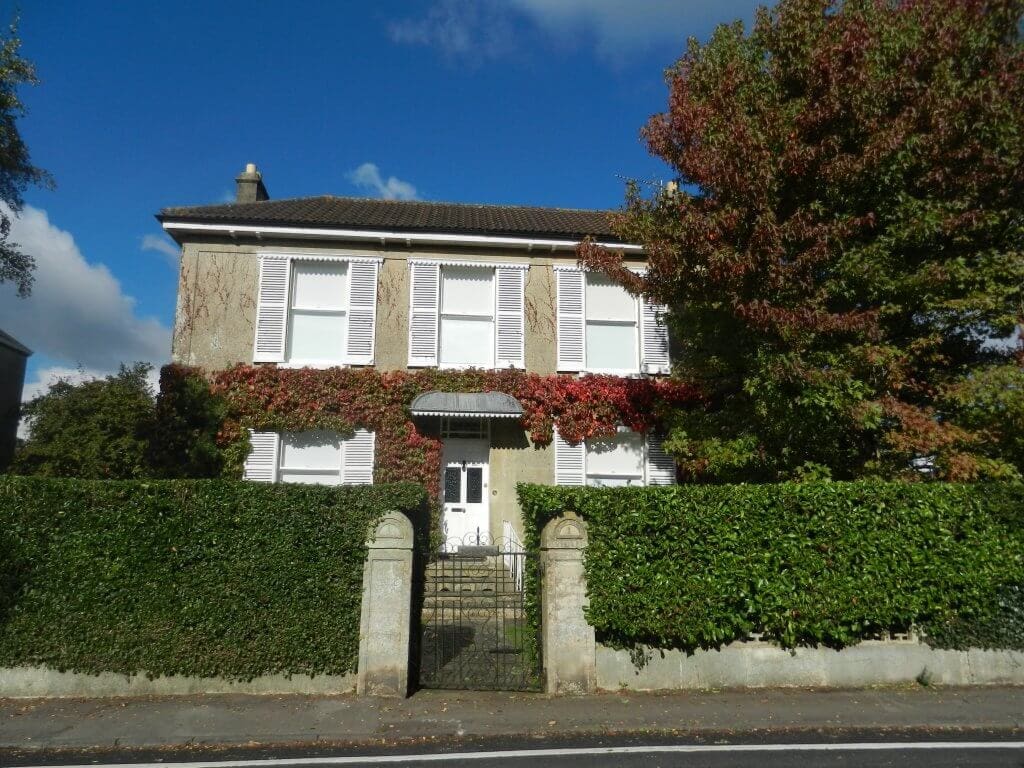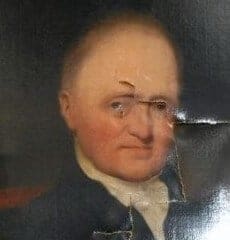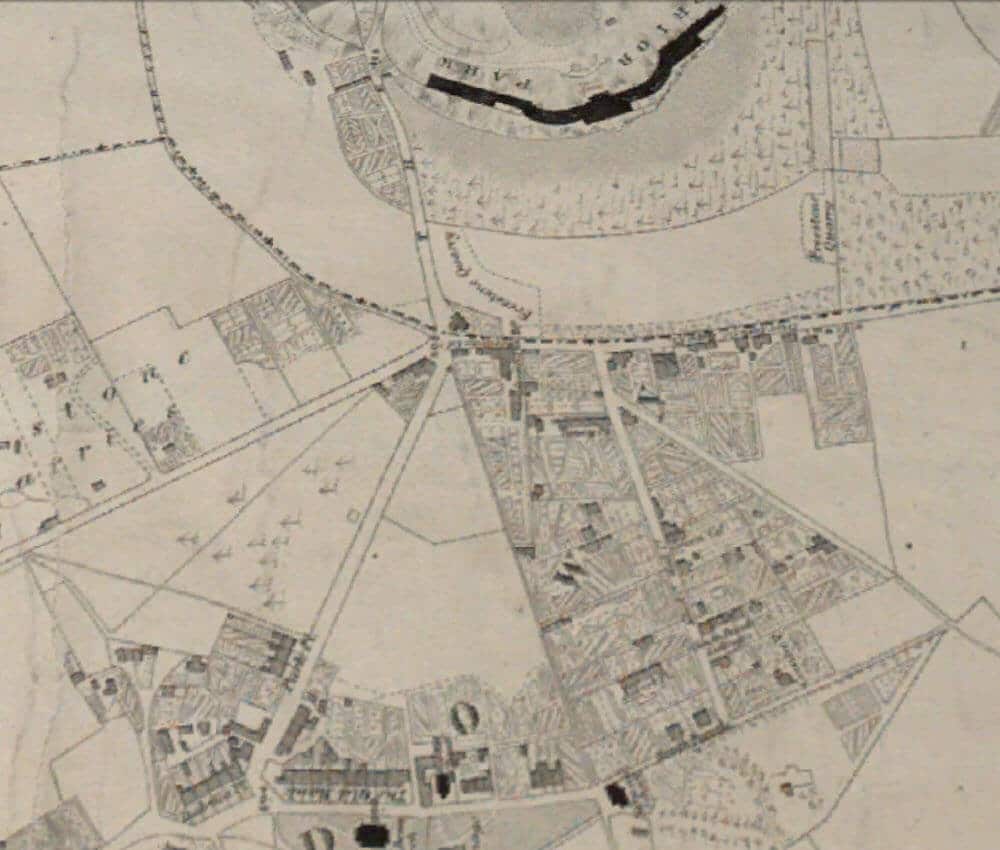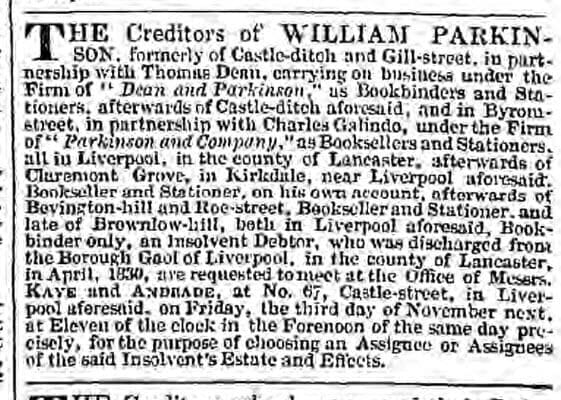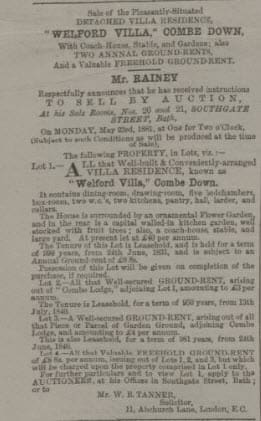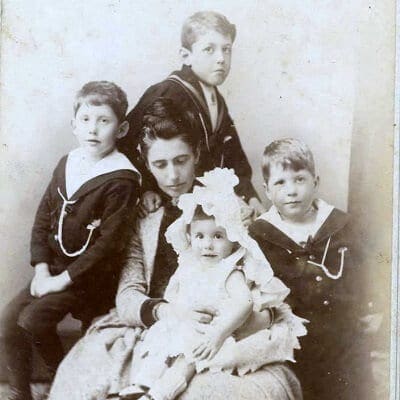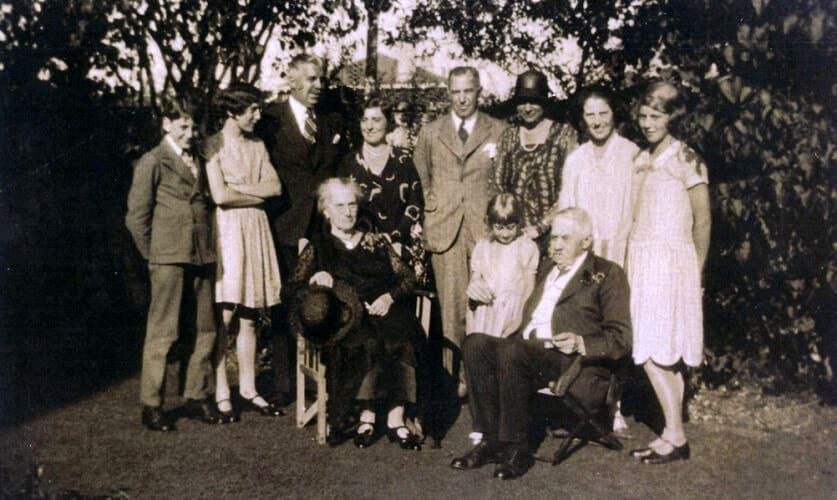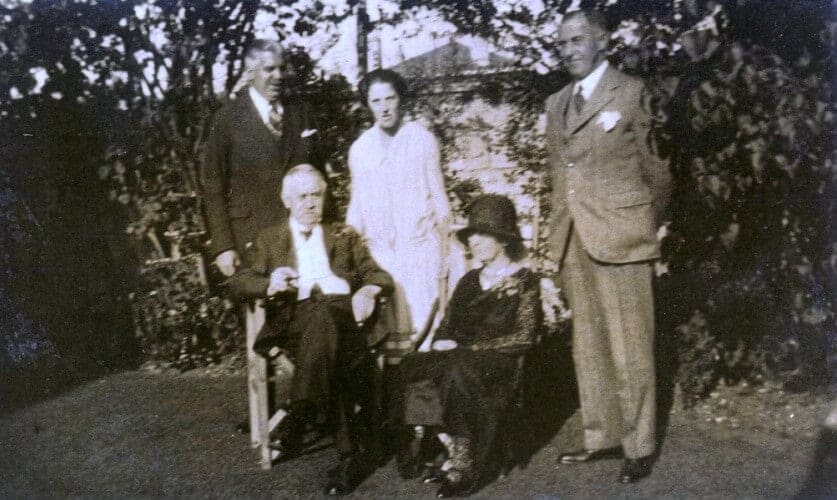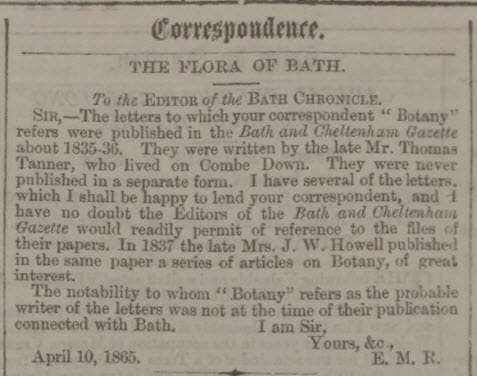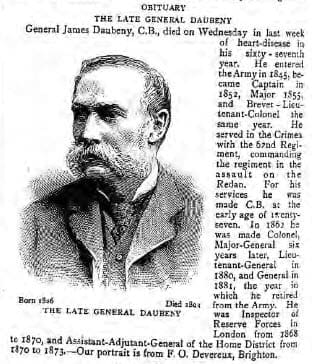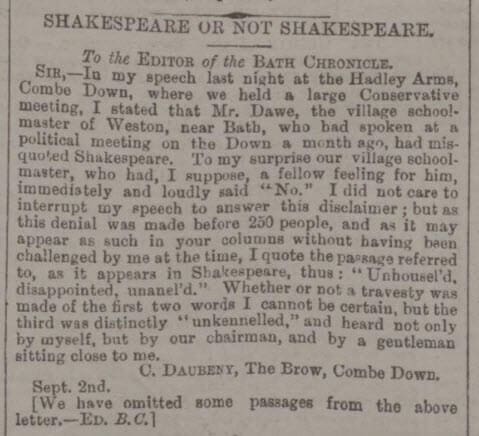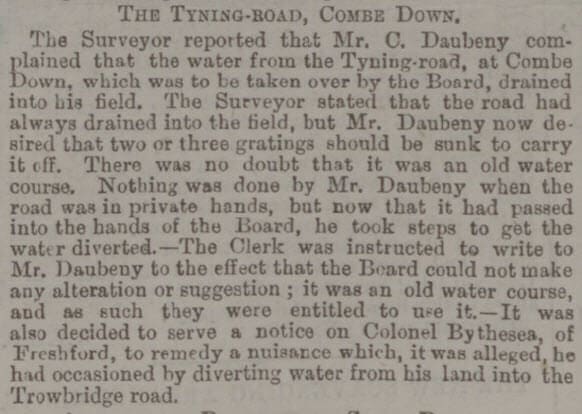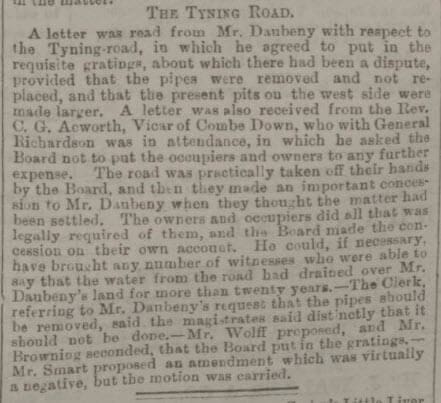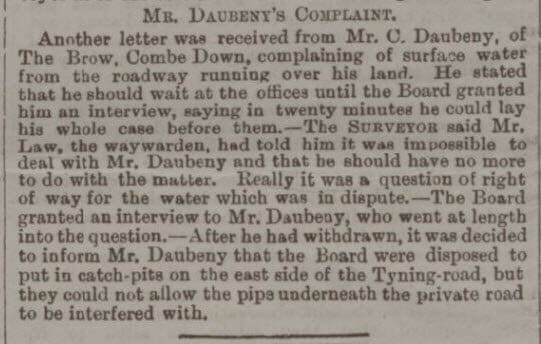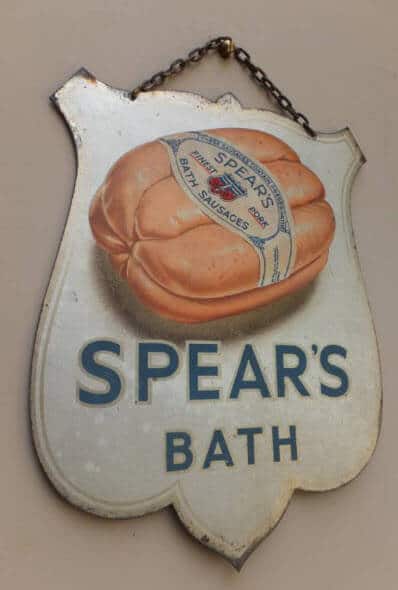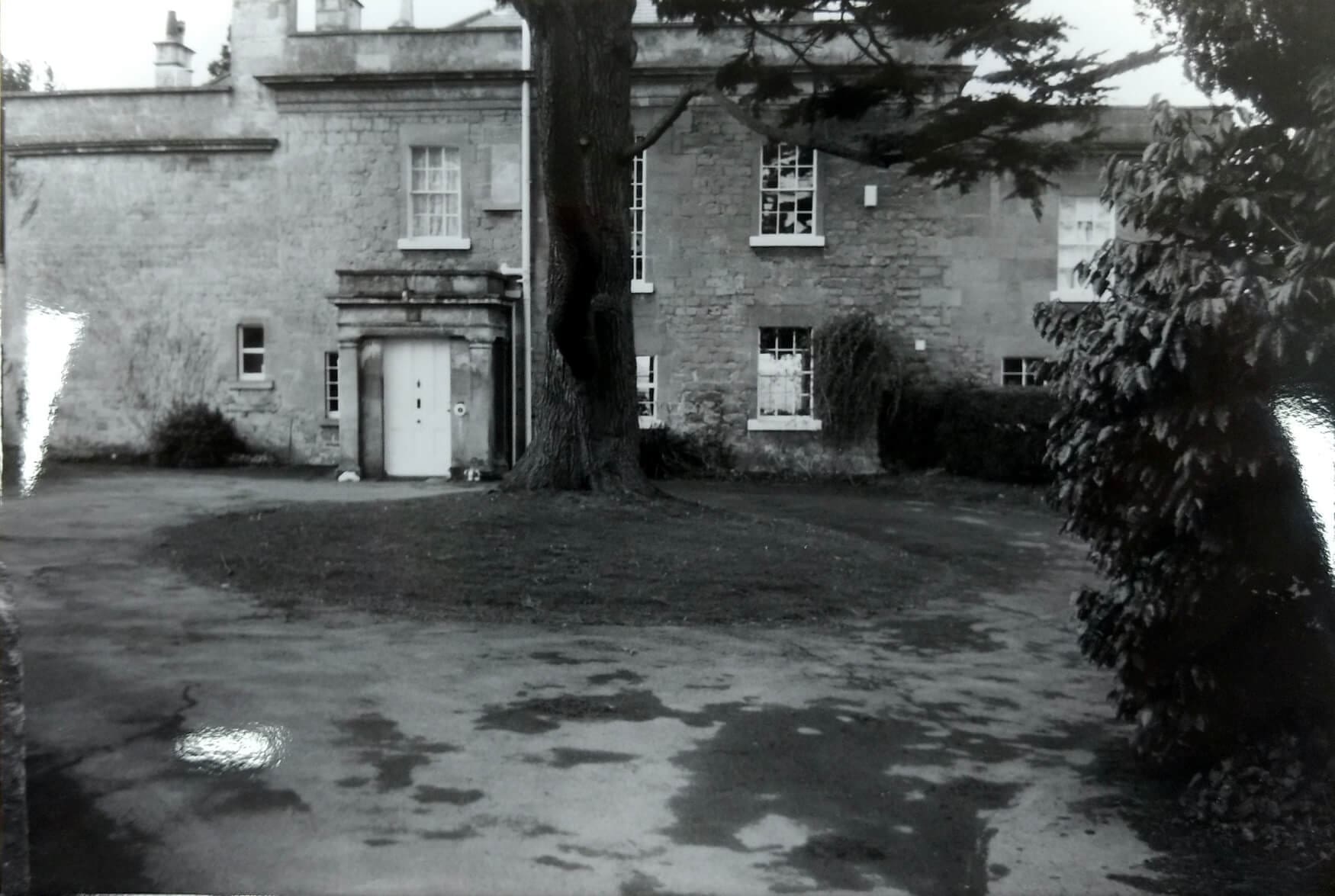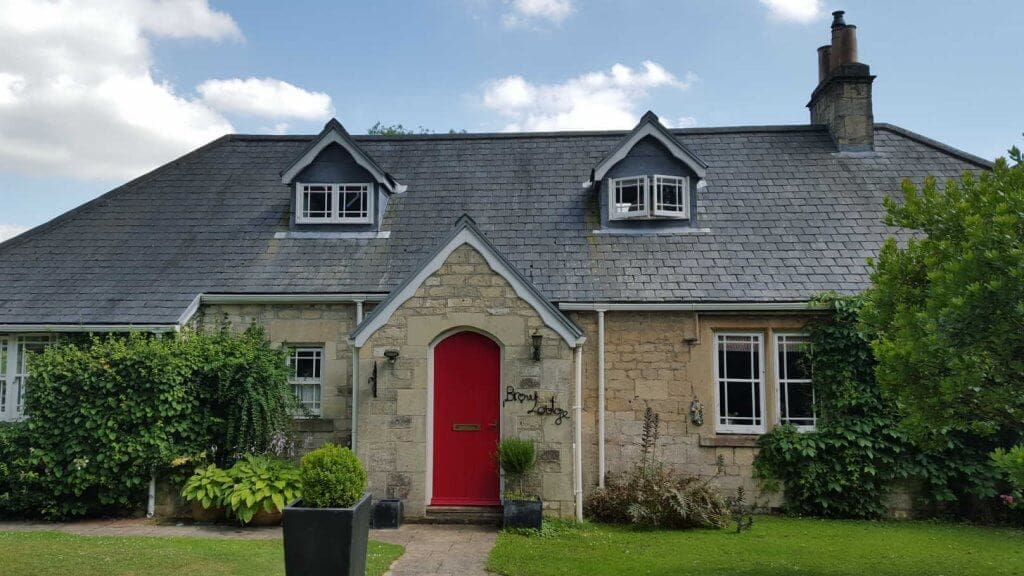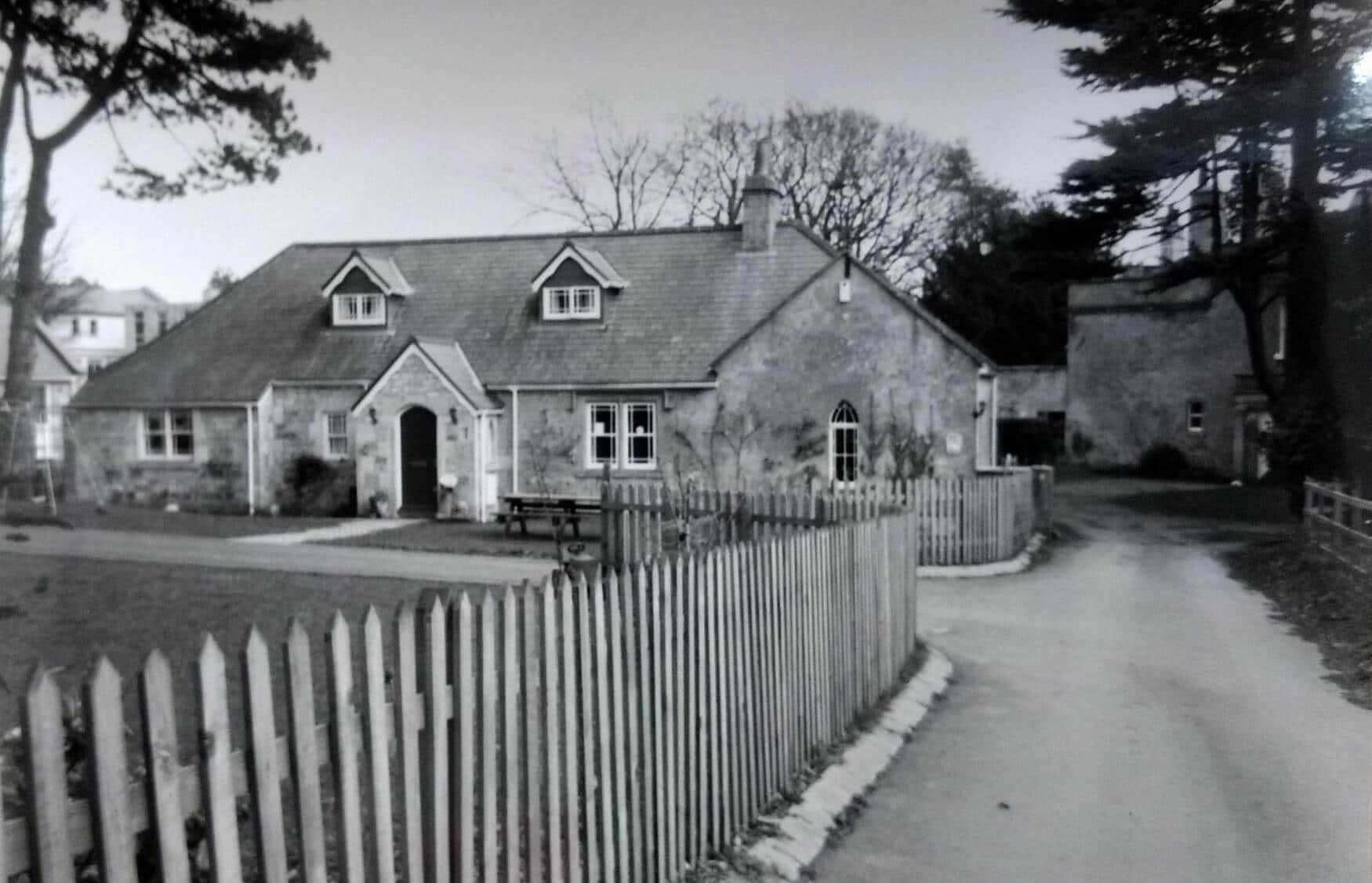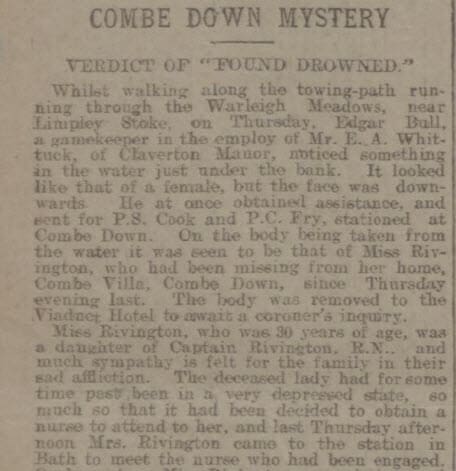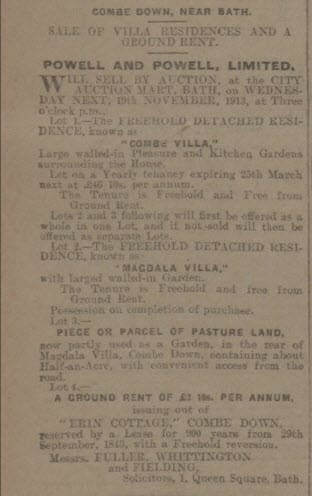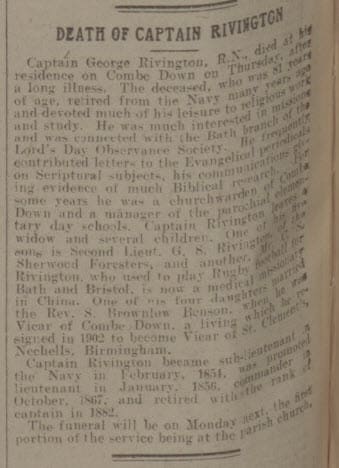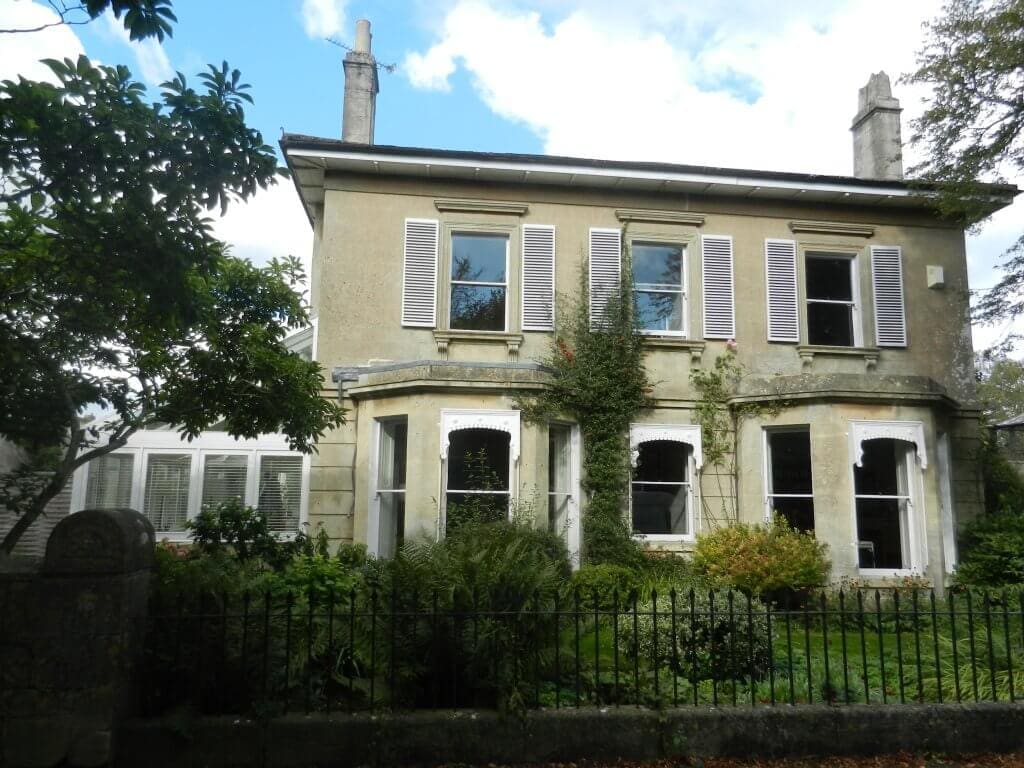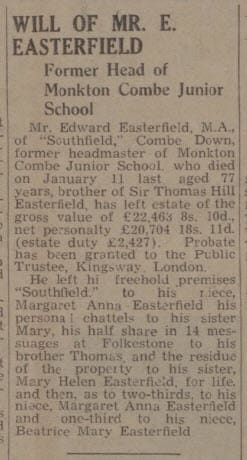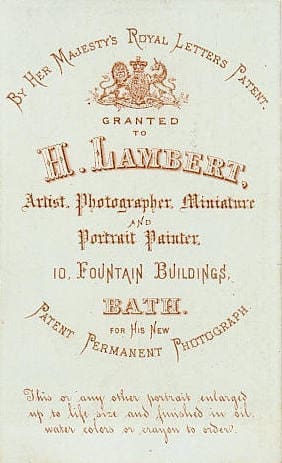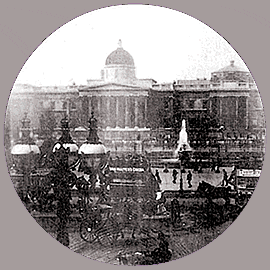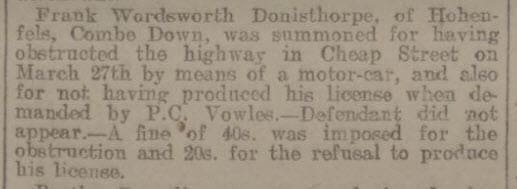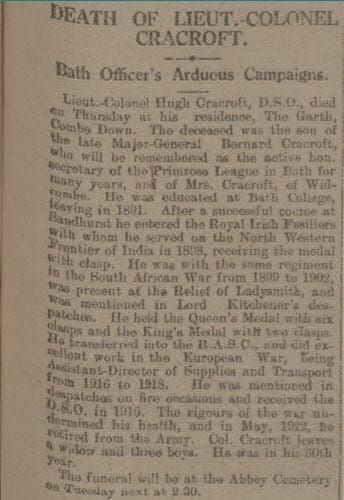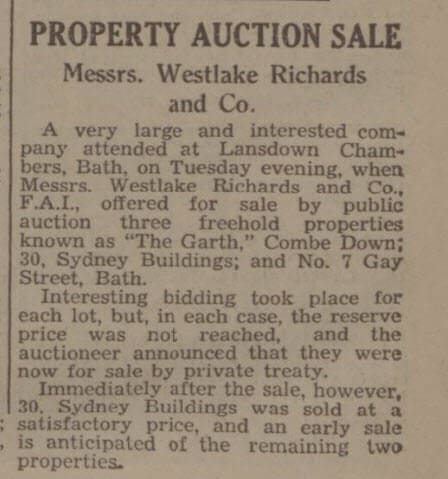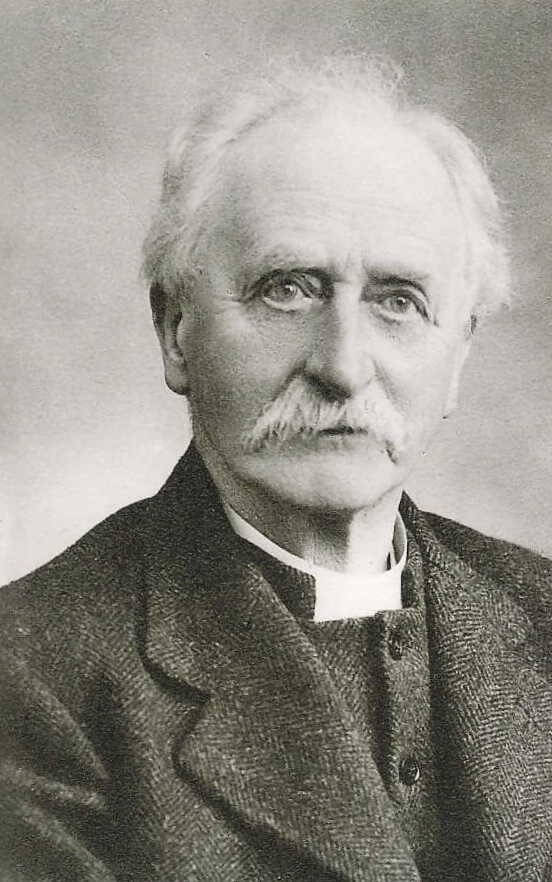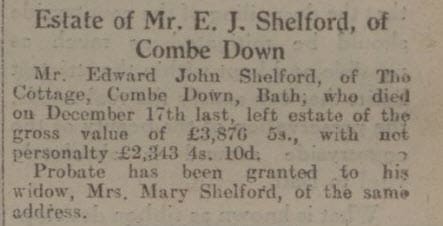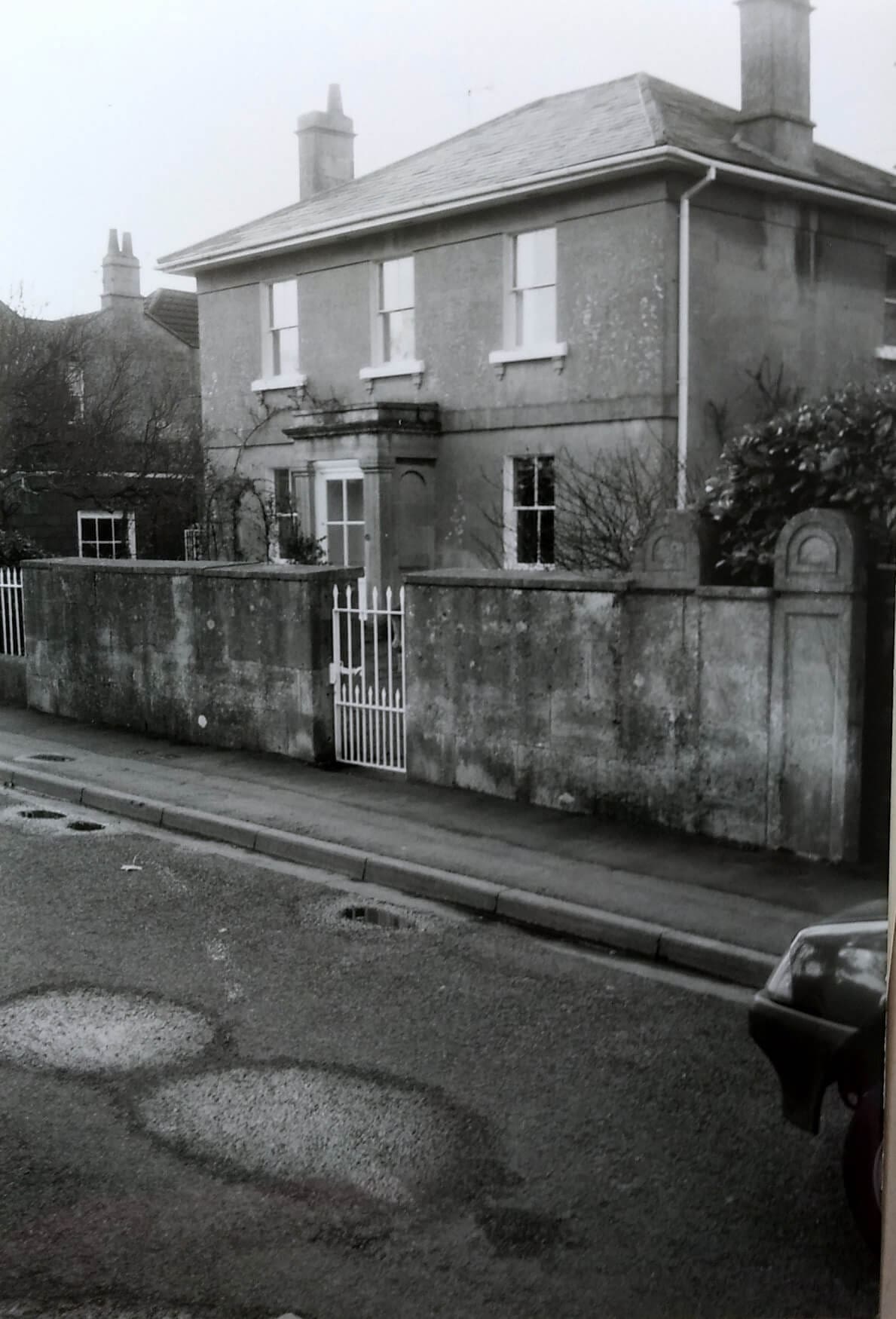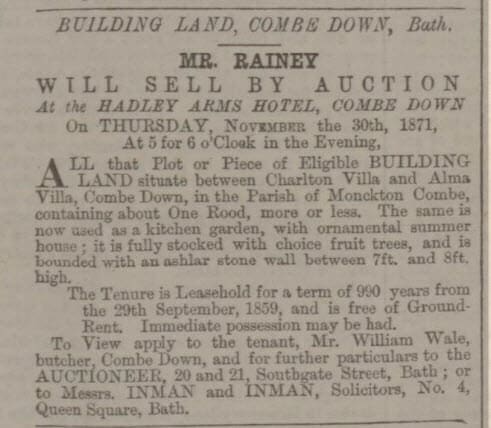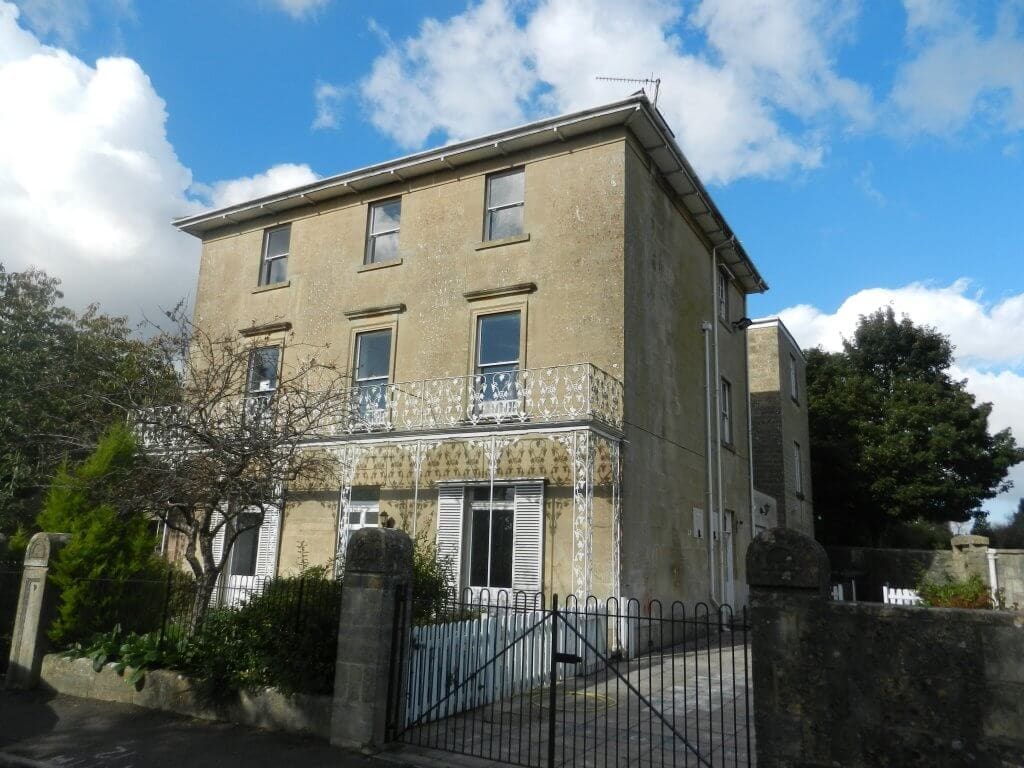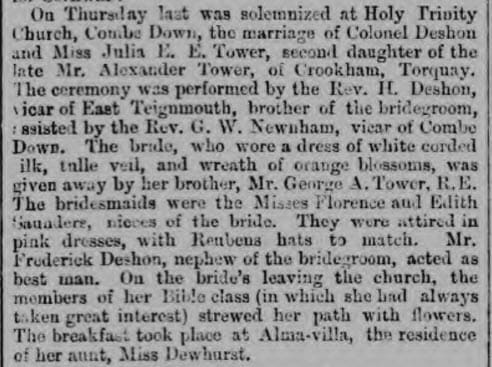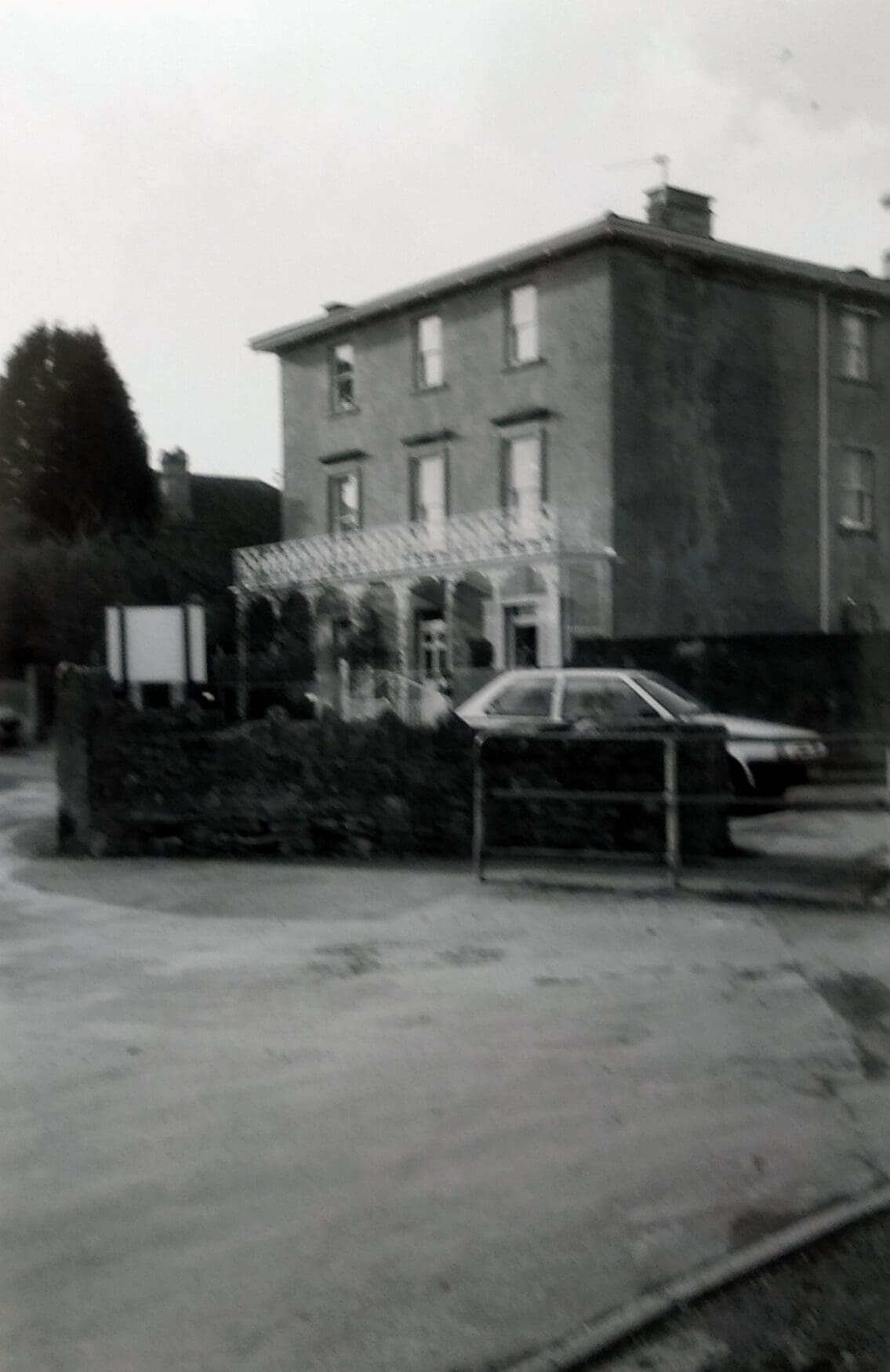Church Road villas
Cotterell’s map makes it clear that before 1852 the villas that existed at the East end of Church Road were The Brow (and Brow Lodge which is said to have been. originally, a chapel for The Brow), probably built about 1830.
Combe Lodge, Welford and Combe Villa (now Scott House) existed too.
None of them appear in the 1841 census but all appear in the 1851 census.
Fowler Villa (now The Garth), Charlton Villa (now Charlton House) and Alma Villa (now Glenburnie) all appear by the 1861 census.
Southfield does not appear until the 1871 census and Rutland Villa (now Overland) not until the 1881 census.
All are shown on the later maps.
Combe Lodge
Combe Lodge first appears in the 1851 census as ‘South Parade’.
As It and Welford House are clearly marked on Plan of the City and Borough of Bath and its Suburbs by J. H Cotterell it could be that the census refers to Welford House.
In any case the occupant was Charles Miller (1775 – 1861) who was Paymaster for Royal Middlesex Militia together with his children and sister in law Catherine Harston Padget (1795 – 1858).
In 1869 it was up for sale and bought by Maj Gen Charles Thomas Harkness (1823 – 1880) of the Madras Staff Corps. After he died it was put up for sale again.
It was probably bought by John H Hamilton who I have been unable to identify further but whose coachman was accused of stealing from him.
In 1884 Combe Lodge was once again for let or sale.
By 1887 it was occupied by Rev Charles Howard (1853 – 1928) who was married to Helen Gertrude Bryan (1860 – 1917), a daughter of Rev Reginald Guy Bryan M. A. (1819 – 1912), the Principal at Monkton Combe School from 1875 until 1894.
His brother Rev Alfred Howard (1857 – 1945) married another of Rev Reginald Guy Bryan’s daughters, Edith Mary Marow Bryan (1866 – 1951) and he was a brother of Rev Richard Nelson Howard (1852 – 1932) who was Vicar of Combe Down from 1892 – 1897.
In May 1888 they started Monkton Combe Junior School at Combe Lodge.
Monkton Combe Junior School used Combe Lodge until 1907 when the ‘new’ junior school building opened where it is now, on land of Kingham Farm.
The land bought from the trustees of the estate of Right Reverend Monsignor Dr. Charles Parfitt (1817 – 1886) after the death of Louisa Brancaccio, Marchesa di Sant Agata (1823 – 1899), who had a life interest in the Midford Castle estate.
In the 1891 census there are 18 people at Combe Lodge including the Howard family, masters, servants and scholars.
In the 1901 census Edward Easterfield (1864 – 1941), (see Southfield) who was junior school headmaster for 30 years is noted with one teacher, a cook/domestic and 16 scholars.
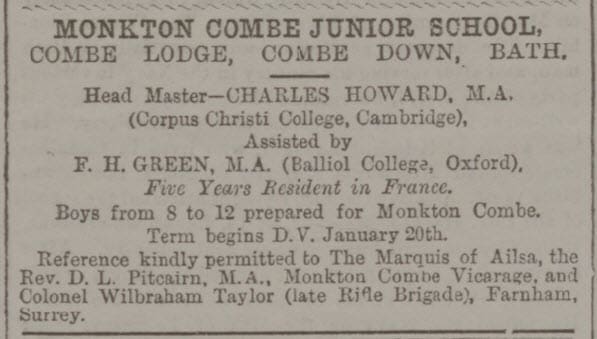
By 1911 Combe Lodge was occupied by Lady Selina Octavia Stewart (1851 – 1938).
Her father was Charles Knox Stuart (1810–1874), 4th Earl Castle Stewart and her mother Charlotte Raffles Drury Thompson (1807 – 1906) a granddaughter of Sir Thomas Stamford Raffles (1781 – 1826) FRS who founded Singapore.
Although she lived at Babbacombe, Devon she frequently visited Bath.
In 1915 the occupant was Richard Harold Demuth (1879 – 1958) who was married to Averil Kate Edwards (1884 – 1963). He was appointed OBE in 1919 for his war service at Harwich.

In 1918 the occupants were Lt Col Wilfred Hubert Wild (1874 – 1953) DSO OBE DL who married Violet Grace Harmsworth (1873 – 1961) a sister to Alfred Charles William Harmsworth (1865 – 1922), 1st Viscount Northcliffe.
He owned the Daily Mail and the Daily Mirror. Their son Victor Louis Vyvyan Harmsworth Wild (1918 – 1980) was born there.
In the 1920s Maj Thomas Herbert Clark (1857 – 1942) JP who was married to Florence Louisa Stebbing (1865 – 1963) moved in to Combe Lodge. His family owned J & T Clark a woollen mill in Trowbridge, started in 1801.
In the 1950s Combe Lodge was bought by the Howard-Kyan family who lived there until 2015 when they moved in to the newly built Garden House next door.
Welford House
Information about Welford has been updated based on research by Tim Lunt, who, with his wife Celia moved in in 1987. Tim has been membership secretary of the Combe Down Heritage Society for many years.
Welford was built, like the rest of Combe Down on a land that was owned by Ralph Allen from about 1730.
Combe Field was owned by William Collibee (1672 – 1728), who was Mayor of Bath in 1719-20, and his widow sold it to Ralph Allen.
Thomas Maude, 2nd Viscount Hawarden (1767 – 1807) sold Prior Park and the estate to John Thomas (1752 – 1827) in 1809.
On taking possession Thomas divided it, by stone partitions, into three parts: one he occasionally let, a second he shut up and he inhabited the third. All this was done to avoid government taxes.
In 1827, when John Thomas died Prior Park mansion and 200 acres was sold to Bishop Baines for £22,000.
In 1828, his son John Ovens Thomas (1778 – 1836) leased parts of Combe Field (see Lot 8 on sale map) for 1,000 years to Thomas Tanner (1771 – 1846) on the condition he builds a “messuage” (dwelling house) within 2 years on the site with a rental value of £10 p.a. Stone quarrying on the site was limited to 20 perches.
The standard area measure in the Imperial system was the acre, which was divided into roods and perches with the measurements shown below.
| Measure | Equivalent |
|---|---|
| 144 square inches | 1 square foot (929 cm2) |
| 9 square feet | 1 square yard (0.8361 m2) |
| 30¼ square yards | 1 perch (25.29 m2) |
| 40 perches | 1 rood (1,012 m2) |
| 4 roods | 1 acre (0.4047 hectares) |
| 640 acres | 1 square mile (2.59 km2) |
In 1830 John Ovens Thomas (1778 – 1836) leased parts of Combe Field (see Lot 7 on sale map below) for 1,000 years to Henry Fowler Cotterell (1791 – 1860), who was, like the Thomas family, a Quaker, and a land surveyor from Bewdley, Worcestershire.
One of Henry’s sons was Jacob Henry Cotterell (1817 – 1868), responsible for the 1852 map of Bath and one of his grandsons was Thomas Sturge Cotterell (1865 – 1950). In 1831 Henry Fowler Cotterell (1791 – 1860) sub-leases the land comprising Combe Lodge, Welford and over Tyning Road plots, for 990 years to Thomas Tanner (1771 – 1846) who built The Brow, Combe Lodge, and Welford.
Further research has shown that John Ovens Thomas (1778 – 1836) and Henry Fowler Cotterell (1791 – 1860) were second cousins.
Their great grandfather was Benjamin Cotterell, born in about 1700 in Bewdley, Worcestershire.
His daughter Hannah Cotterell (1727 – 15 Dec 1791) married his maternal grandfather John Ovens (1720 – 28 Mar 1772).
Benjamin Cotterell’s son, also called Benjamin (1732 – 2 Dec 1786), was Henry Fowler Cotterell’s paternal grandfather and Hannah Cotterell (1727 – 15 Dec 1791) was his great aunt.
With them both being Quakers or members of the Religious Society of Friends, and being, like many religious groups, committed to the care and welfare of those within their community.
This was especially so because of the Quaker experience of exclusion and persecution as dissenters meant that they gave great weight to practical dealings with each other.
Thomas Tanner (1771 – 1846) was also a non conformist and contributed towards Union Chapel.
These family and dissent relationships may have contributed to their business dealings.
By comparing Ralph Allen’s estate map (which is OK to do as this part of Combe Down was undeveloped until John Ovens Thomas (1778 – 1836) sold it) with the the map for the sale of the remains of the estate by the executors of, John Ovens Thomas (1778 – 1836) in 1846 and the detail of Jacob Henry Cotterell‘s map of 1852 one can see the development that took place in the 20 years or so from 1828. Much of this development was done by Henry Fowler Cotterell (1791 – 1860).

When Thomas Tanner (1771 – 1846) died Henry Fowler Cotterell (1791 – 1860) sold the freehold of Lot 7 to Tanner’s son Joseph (1799 – 1878).
Welford Villa first appears in the census in 1871 when Ann Galindo (née Carless) 1803 – 1886 and her 5 daughters are living there. They also appear in the 1881 census.
Ann was the widow of Charles Galindo (1797 – 1868) whose father Samuel Galindo (1747 – 1809) had converted to christianity – the Galindos were Sephardi Jews from the Iberian peninsula.
Charles went into partnership with William Parkinson as booksellers, bookbinders and stationers but it’s likely this ended badly as Parkinson was jailed as a bankrupt.
He also offered foreign exchange with his brother Samuel and offered assistance to would be emigrants. Later he moved to Shalbourne as a ‘Lay agent Teacher of Christianity’ before moving to Combe Down.
The Galindos are living at Claremont, 109 Church Road in the 1861 census. none of the daughters married.

In 1881 Welford Villa was up for sale.
In 1891 Welford Villa was occupied by Mary Anna Howard (née Nash) (1853 – 1913).
She was the widow of Stanley Howard (1850 – 1883), a brother of Rev Charles Howard (1853 – 1928) who was married to Helen Gertrude Bryan (1860 – 1917) and of Rev Alfred Howard (1857 – 1945) who had married another of Rev Reginald Guy Bryan’s daughters – Edith Mary Marow Bryan (1866 – 1951).
Mary Anna had her 3 daughters and her widowed father, a governess, two servants and three Monkton Combe Junior School pupils living with her.
By the 1901 census there were seven school boarders and five adults at Welford.
Like Combe Lodge next door Monkton Combe Junior School used Welford until 1907 when the ‘new’ junior school building opened where it is now.
Mary Anna Howard (née Nash) (1853 – 1913), the wife of the first headmaster, was reputed to have suggested the idea of a Junior School which was initially started in Combe Lodge and then extended to include Welford with a connecting corridor and small gymnasium.
There were three Headmasters at the school while at Welford: Rev Charles Howard (1853 – 1928) from 1890 – 1893, Rev John Willis Kearns (1862 – 1962) from 1895 – 1900 and Edward Easterfield (1864 – 1941) from 1900 – 1907.
Kearns apparently turned down the job at first as he thought the facilities too “primitive” but was later persuaded.
By the time the new Junior School was built in 1907 there were 60 pupils boarding at various houses around Combe Down.
In 1911 Welford Villa was being run as a boarding house in a joint venture between Marion Pauline Matthews (1855 – 1937), the daughter of Rev John Henry Dudley Matthews (1844 – 1914) and Edith Annie Selfe (1850 – 1942), and Augusta Elizabeth Morice (1846 – 1943) daughter of Rev Charles Morice (1815 – 1895) and Augusta Mary Ann Zouch (1816 – 1888).
In the 1901 census they are shown as running a boarding house in Barmouth, so this was not their first venture.
Marion Pauline Matthews (1855 – 1937) was descended from Edward Hyde, 1st Earl of Clarendon (1609 – 1674) and Augusta Elizabeth Morice (1846 – 1943) was related to Col William Lowther, 1st Earl of Lonsdale (1757 – 1844).
This boarding house was amongst some memories recalled to Tim Lunt by Mr Thomas Francis Aubrey Prescott (5 Mar 1904 – 2003).
- Born in 1 Albert Place, the road running behind Welford, in 1903
- When Welford was a guest house during WW1 there was a sign on the gate “En Pension”
- He was hit by a ball thrown from Welford by a schoolboy one day as he walked past
- A child was drowned in the drain by the postbox on the corner of Tyning Road
- A cart with 2 horses bolted down Tyning road and crashed into the wall on Church Road
- The stables over the road from Welford were used as the base for a taxi horse and gig running down Ralph Allen Drive to Bath
In 1920 Welford was sold to Dr William Ingram Keir (1854 – 1933) and his wife Emily Elizabeth Mary Young (1849 – 1937) who changed the name to Inveresk as Augusta Elizabeth Morice (1846 – 1943) had moved her boarding house to Graham House on The Avenue and changed its name to Welford, presumably for continuity.
The Keirs extended the house, building the back wing.
One of the Keirs’ sons William Ingram Keir (1883 – 1967) became an architect and, inter alia, was responsible for the design of the Lascar War Memorial in Calcutta built in the honor of 896 Lascars, who died fighting for the Royal Navy during the First World War.
The 100 ft memorial is built in the Indo-Mughal style. It has the prows of an ancient galley projecting from each side and is capped by four mini minarets and a large dome. Along the facade are undulating lines symbolizing waves.
In 1937 Dr Robert Henry George Hector Denham (1897 – 1994) and his wife Kathleen Leicester (1904 – ) bought Welford or Inveresk as it was still called. They later lived at Orchardlea on The Avenue.
As well as being Medical Officer for Bathavon RDC he was the first chairman of the committee of Bath Symphony Orchestra which gave its first public concert at the Pavilion on January 17th 1949.
In 1965 Dr John (Jack) Ferens Turner (1930 – 2002) and his wife Dr Anne Curtis Turner (née Pyke) (1939 – 2006) bought Welford.
They and their family later lived at The Parsonage later The Vicarage later The Old Vicarage for many years and there is much more about them in The History of Combe Down Surgery section.
Mr & Mrs Brackenbury, were the occupants from 1976 – 1984. Brackenbury worked for the MoD.
Mr & Mrs Drake Lee, were the occupants from 1984 – 1987. Drake Lee was an ENT specialist at the RUH.
Tim & Celia Lunt, are the current occupants arriving in 1987. Tim worked with computer systems and Celia ran a chiropody practice from Welford for many years.
The Brow
The Brow was built around 1830 by Thomas Tanner (1771 – 1846).
He married first Elizabeth (abt 1771 – 1831) and then Mrs Sarah Simpson (née Shenstone) (1776 – 1853). With his first wife he had three daughters Maria (b. 1808), Fanny Jane (1809 – 1852) and Sarah (b. abt 1810).
Other than these bare facts I have found it difficult to establish more about him, other than that he paid for the building of Combe Down School and contributed to the building of Holy Trinity.
There is also a letter in the Bath Chronicle and Weekly Gazette of Thursday 13 April 1865 that suggests he was interested in botany.
Brow Lodge is said to have been the chapel for The Brow originally, but certainly by the 1841 census it was being used as a house for Joseph (b.1791) and Mary Gane (née Hemmings) (b. 1791) and their children James, Fanny and Sarah.
About 3 years after his death the furniture and effects of The Brow were sold at auction.
By 1851 The Brow was occupied by John Griffith Mansford (1788 – 1863) and his second wife Augusta Snow (1807 – 1872).
His first wife had been Mary Street (1791 – 1838).
John Griffith Mansford was a surgeon who published a number of works including: An Inquiry Into the Influence of Situation on Pulmonary Consumption, and on the Duration of Life: Illustrated By Statistical Reports in 1818 and Researches into the nature and causes of epilepsy, as connected with the physiology of animal life, and muscular motion in 1819.
In 1833 he was mentioned in the: “Will of Richard Ogborn, Gent of Bath, Somerset 1833 Of Kensington Place, Bath” and left:
"...all my freehold and leasehold properties in The Grove, Camberwell, and in Market Southwark, Surrey or elsewhere., inc my leasehold house at Kensington Place."
He was also a Writer on Prophecy and specifically about Millenarism. He wrote The Sixth Seal, and the Seventh Vial in 1848 and Anno Mundi 1656, and Anno Domini 1849 in 1849,
After he died The Brow was put up for sale by the Tanner family.
The 1861 census has the house occupied by Joseph (b. 1799) and Maria (b. 1808) Tanner.
He was from Hampstead Norreys in Berkshire and seems not to have been related to Thomas Tanner – I have not been able, so far at least to prove that he was. His father and grandfather were described as ‘Gentlemen’ and owned land in Berkshire.
However, as Thomas Tanner had a daughter named Maria (b. 1808) and his wife is a Maria (b. 1808) it seems a great coincidence and, thus, possible that she married a cousin or just someone with the same surname.
By 1871 The Brow was occupied by Charles William Daubeney (1816 – 1895) and his wife Sarah Maria Cripps (1819 – 1906).
Although any genealogy before 1500 has many uncertainties and even experts disagree on well known lineages it is generally accepted that the Daubeny family was of direct Norman descent in the male line, though there were spelling variants d’Aubigny, d’Aubigni, d’Aubigne, d’Albini et al.
Col Henry Daubeney, (1779 – 1853) was a keen genealogist and compiled a manuscript pedigree.
His son, Gen Sir Henry Charles Barnston Daubeny, G.C.B. (1810 – 1903) continued his work on the pedigree with additions and corrections, and it was printed in 1884, but only as far as 1841.
It seems that the Daubeney family really are descended from people who came over with William the Conqueror even if they were not companions of William the Conqueror. On the Battle Abbey Roll [see list] and the Falaise Roll appear:
- Guillaume d’Aubigny
- Le Sire d’Aubigny (Roger)
- Neel Vicomte de St-Sauveur
On the Dives sur Mers plaque appears only:
- Niel d’Aubigni
Guillaume d’Aubigny (1010 – 1066), seigneur de Saint-Martin-d’Aubigny was cupbearer to William the Conqueror and married to Adeliza filia Osulf de Plessis (1020 – 1088), Heiress of Belvoir.
His father was Niel de St Sauveur (986 – 1066) Vicomte de Cotentin and his mother Adela Senlis d’Eu (985 – 1066) otherwise know as Adela de Brionne.
Through these connections he can trace his ancestry back to Richard “Sans-Peur” Fitz William (933–996), Duke of Normandy and from there to Ivar Halfdansson (c. 757 – 824) Jarl of The Uplands.
All of this means that Charles Daubeney could trace his line back a very long way. More recently he was descended from George Daubeny (1687 – 1740) who had moved from Dorset to Bristol in 1701.
He was apprenticed as a grocer to a Dawbeny Buckler. In 1710 he completed his apprenticeship and became a Freeman of Bristol. He founded a business of sugar refining and distilling and became a prosperous and wealthy man.
His second apprentice was Charles Abington who married his sister Jane. After completing his apprenticeship, Abington and George jointly undertook the training of Robert Bridle as a grocer.
Bridle was the son of a Dorset gentleman from Leigh. On the completion of Bridle’s training and when he became a Freeman, he entered the Halliers Lane firm as a clerk and George made him a trustee with his son George Daubeny (1713 – 1760).
By 1748 the firm was trading as Daubeny & Bridle. The family association was clearly strong since one of the grandsons had Bridle included in his name Dr. Charles Giles Bridle Daubeny (1795 – 1867) FRS. All of this meant the family had stayed wealthy.
One of his sisters Elizabeth (1814 – 1892) married Sir Martin Hyde Crawley Boevey (1812 – 1862) of Highgrove.
One of his brothers Rev George Barnston Daubeny (1812 – 1869) married Albinia Anne Crawley Boevey (1810 – 1850) who was Sir Martin Hyde Crawley Boevey’s sister.
Another of Sir Martin Hyde Crawley Boevey’s sisters, Matilda Blanche Crawley Boevey (1817 – 1887), was married to William Gibbs (1790–1875) of Tyntesfield.
The Crawley Boevey’s are, apparently, descendents of William the Conqueror, Ferdinand I of Leon and Castile, Alphonso I of Portugal, Hugh Capet and Charlemagne through Susanna Lloyd (1712 – 1762); mother of Sir Thomas Crawley Boevey, 2nd Baronet.
Another brother was Gen James Daubeney (1826 – 1893).
All of this meant the family was well connected.
Charles William Daubeney was a surgeon.
He seems to have been confident, perhaps even arrogant and sure of his own beliefs and that he was correct.
I say this based only on two items.
Firstly, two letters he wrote to the Bath Chronicle about a Shakespearean quotation.

Secondly, something that became a bit of a local cause célèbre.
There were articles or letters about it in the Bath Chronicle and Weekly Gazette on Thursday 23 September 1886, Thursday 21 October 1886, Thursday 25 November 1886, Thursday 2 December 1886, Thursday 23 December 1886, Thursday 6 January 1887, Thursday 20 January 1887, Thursday 26 May 1887, Thursday 23 June 1887, Thursday 30 June 1887, Thursday 25 August 1887, Thursday 22 September 1887, Thursday 21 July 1892, Thursday 22 September 1892 and Thursday 30 November 1893.
Charles Daubeny complained that the completion of Tyning Road was causing water to flow over his land and wanted something done about it.
Many people suspected that it was only because the Highways Board had taken over the road and it’s upkeep that he complained as he felt he would get better drainage around his property paid for by the Highways Board.
I have laid out some of the letters and articles below.

I have no idea whether the whole rather sorry saga was resolved before Charles Daubeney died on 27 Dec 1893, but I suspect not.
Sarah Maria Daubeney (née Cripps) continued to live at The Brow after Charles Daubeney’s death and when she died in 1906 their son Capt Charles William Daubeney (1860 – 1937) DSO and his wife Edith Henrietta Gore (1852 – 1931) moved in.
Edith Henrietta Gore was a daughter of Mary Eliza Gore (née Hole) (1813 – 1891) who had lived at 6 De Montalt Place and sister of of Caroline Letitia Gore (1843 – 1920) who was the third wife of Rev Reginald Guy Bryan M. A. (1819 – 1912) who had been Principal at Monkton Combe School from 1875 until 1894 and who lived at 6 De Montalt Place.
Capt Daubeney spent some years in the service of Sir James Brooke, Rajah of Sarawak, KCB (1803 – 11 1868) and first of a line of ‘White Rajahs‘ in Sarawak but left Sarawak in 1904. After this he took a commission in the Somerset Militia and, later, transferred to the 3rd Somersets, the Special Reserve.
He retired from military service in 1909 but volunteered for service on the outbreak of WWI and served with a Training Reserve Battalion in the Midlands.
When Capt Daubeney retired from military service in 1909, one of the first things he did in 1909 was become Vice Chairman of the Performers Committee of the Bath Historical pageant.
Bath Historical Pageant took place over five days (19 – 24 July) in 1909 at Royal Victoria Park.
It involved more than 3,000 costumed performers most of whom had never acted before and told Bath’s story in a series of tableaux.
A procession of beaux, bishops, kings and Roman centurions, it was the appearance of Bladud driving his pigs through a swamp that caught the public’s imagination. The pageant helped to lead to a reawakening of interest in the significance of Bath’s history and development.

Capt Charles William Daubeney and his wife Edith Henrietta Gore had 4 children, 3 daughters and a son. Their son was killed in WWI.
Capt Charles John Odinel Daubeney (1895 – 1917) had joined the Somerset Light Infantry at the outbreak of the war and had been injured twice before he died.
He has a memorial window in Holy Trinity church.

One of their daughters Joan Maud Daubeny (1894 – 1985) married Henry Mildmay St John (1882 – 1946) the eldest son of Henry St John 5th Viscount Bolingbroke, 6th Viscount St John (1820 – 1899).
As the eldest son he might have inherited his father’s titles except for the fact that he was illegitimate.
His mother Mary Elizabeth Emily Howard (1859 – 1940) was the daughter of Robert Howard (b. 1833) and Susannah Hiscock (1838 – 1910).
Her father had been an agricultural labourer and mail coach man and she was a servant at Lydiard Park – the family home of the St John’s since 1420.
He made her his housekeeper and she became his mistress. They would come to Bath and live as a couple, known as Mr. and Mrs. Wilson. In 1882 and 1885 Mary gave birth to two boys and in 1893, pregnant a third time, she persuaded Henry to marry her.
They married at Bath Registry office in 1893. The child was stillborn, but three years later she gave birth to a boy, who was christened Vernon Henry St John (1896 – 1974) and became the only legitimate heir to the title and the 6th Viscount Bolingbroke & 7th Viscount St John.
Henry St John’s affair with Mary was not his first. Before her, in 1852, he had met Ellen Medex (1836 – 1885), daughter of Charles and Miriam Medex.
They never married but lived as Mr, and Mrs, Morgan for over thirty years in London and Brighton. Ellen gave birth to four children, only one of whom, Ellen Rose St John Morgan (1863 – 1942), survived. Ellen was buried at Highgate Cemetery as ‘Ellen, Viscountess Bolingbroke’.
After Capt Daubeney died in 1937 The Brow was bought by George Frederick Spear (1879 – 1946) MA LLB.
His father George Edwin Spear (1850 – 1914) had started, in 1875, a small wholesale provision business in Bristol.
He was joined by his brother, Frederick William Spear (1859 – 1935) the following year, and by another brother, Edward Albert Spear (1866 – 1951), in 1879. After acquiring the Victoria Street firm of William Clark and Sons in 1898, the name became Spear Bros and Clark Ltd.
The brothers sold a whole range of pork products – pies, sausages, black puddings, saveloys, polonies and faggots. But their speciality was Bath chaps – a quarter of a pig’s face, cooked in breadcrumbs and sold ready to eat.
As well as trading from shops in Bath and Chippenham they also supplied other businesses throughout the South West. They made their deliveries in a fleet of distinctive green vans bearing the company logo.
When George died in 1914 he was succeeded by his brother Fred, who became Mayor of Bath.
When he died in 1935, Edward became chairman. George’s son, George Frederick Spear, who had been educated at Monkton Combe school and practiced as a barrister in London became a director when his father died, and his son Richard David Spear (1917 – 2014) eventually became chairman.
The business moved to Broad Plain, off Old Market, in 1963.
In 1973, Spear’s – now owned by Unigate – closed all its shops to concentrate on wholesale distribution from factories in Bristol, Cornwall and Kent. At the time, the company employed 185 people.
A few months later, Spear Bros merged with Bristol coffee company Carwardines in a £800,000 deal.
A new factory was fitted out at Brislington and new sales depots created in Swindon and Cardiff. In 1975, the firm was sold to two ex-directors of Trowbridge meat company Scot Bowyers, which specialised in pork pies.
George Frederick Spear was married to Meta Elisabeth Baudert (1887 – 1941) and they had 4 children.
Richard David Spear (1917 – 2014) and his wife Mary Douglas Orr Ewing (b. 1926) inherited The Brow and lived there until 1992 when they moved to a property in the new development built on their land.
Their daughter Mary Frances Spear (1913 – 2006) was an international women’s cricketer who played in the first four Test Matches against Australia and New Zealand in 1934-35, and helped England win the Ashes. There are many Spear’s family graves and monuments at St Michael, Monkton Combe.
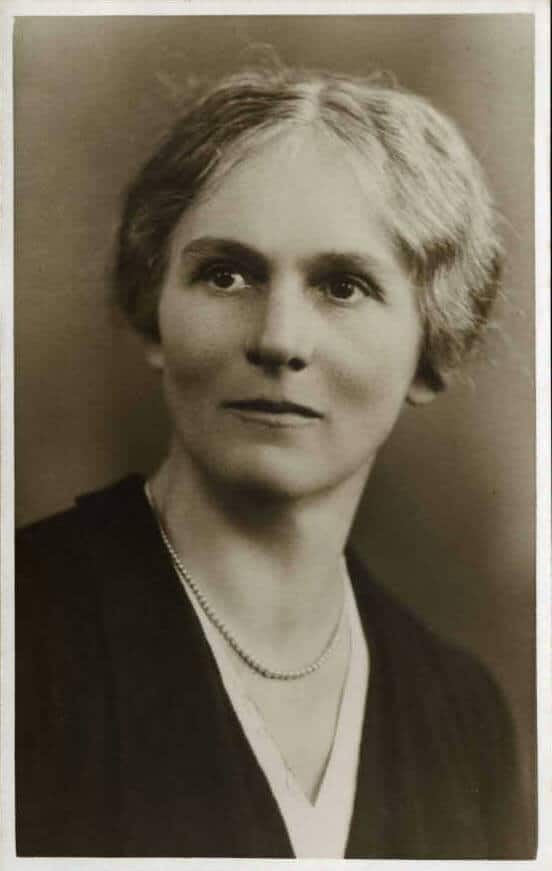
Brow Lodge
Brow Lodge is said to have been originally a chapel for The Brow but by 1841 it was being used as accommodation for a Joseph Gune (Gane) (1791 – 1863) and his wife Mary Hemmings (1796 – 1870) and their 3 children James (b. 1825), Fanny (b. 1827) and Sarah (b. 1831). He is described as an Agricultural Labourer.
By 1851 Brow Lodge accommodates George & Sarah Nott (Coachman & Laundress).
George Nott is, in fact George Knott (1807 – 1870) and his wife is Sarah Mees (1799 – 1885) the parents of Richard Henry Knott (1840 – 1907) who was a solicitor’s clerk and whose sister was married to John Cook (1841 – 1903) who lived at 113 Church Road from 1898.
In 1861 Joseph Gane (1791 – 1863) as a General labourer is back at Brow Lodge with his grand son Robert Gane (b. 1847) noted as a ‘helper in stables’.
In 1871 William Merchant (1812 – 1893) described as a Gardener and his wife Mary Moore (1808 – 1894) together with two of their five children, Thomas Humphrey Merchant (1850 – 1925) and George Richard Merchant (1854 – 1917), occupy Brow Lodge.
No occupant is given in the 1881 census.
For 1891 and 1901 George James Johnson (1848 – 1924) described as groom & gardener, and his wife Fanny Elizabeth Prichard (1865 – 1957) with their children George Conrad Johnson (1889 – 1964), Alice Mabel Johnson (1890 – 1951), Ethel Muriel Johnson (1895 – 1981) and Annie Gertrude Johnson (1899 – 1985) occupy Brow Lodge though by 1911 they had moved to Lonsdale in De Montalt Place.
In 1911 occupation is by (Lewis Charles) Mercer Blackmore (1880 – 1922 )described as a Gardener and his wife Annie Emma Rhymer (1887 – 1965) as well as one of their children – they eventually had six – Nora Annie Blackmore (1910 – 1988). In 1913 the Blackmores emigrated to Ontario, Canada.
Scott House
In 1871 the census has Ernest F B Cyres (age 2) and Louisa R Nash & Catherine A Hawkins (Servants) at Combe Villa.
Clearly Ernest’s parents were away, but I have been unable, so far, to discover who they were.
It could, of course, be that the name given – Cyres – is incorrect and it should be say, Syer.
But…. now in 2020 I have identified who was living there. It was Ernest Frederick Beavan Eyres (1868-1944), the son of George Eyres (1838-1890) and Lydia Ann Beaven (1840- 1926).
George Eyres was a silk mercer, outfitter and milliner of G. Eyres & Son, 17 Milsom Street. They had moved to Bloomfield Road by 1881 but Mrs Eyres was living at 1 Isabella Place in 1901.
In 1881 Maria Mosley (1840 – 1917) who describes herself as a Governess was living at Combe Villa.
She was the great grand daughter of Sir John Parker Mosley (1732 – 1798) 1st Baronet Ancoats of Rolleston Hall. Sir Oswald Ernald Mosley (1896 – 1980) 6th Baronet Ancoats the founding leader of the British Union of Fascists was a cousin.
By 1891 Combe Down School run by William Franklin occupied the house as it did Southfields next door.
By 1901 Capt George Rivington RN (1833 1915) and his wife Jane Eleanor Sangster (1844 – 1937) were living at Combe Villa.
George Rivington was the grand son of Charles Rivington (1754 – 1831) who was a partner in Rivington & Co. a London publishing company founded by Charles Rivington (1688–1742)
Their daughter Nellie Sangster Rivington (1873 – 1927) married Rev Sawrey Brownlow Benson (1861 – 1918), who was Vicar of Combe Down from 1897 – 1902, in 1898.
In 1908 their son Harry Sangster Rivington (1874 – 1931) married Ethel Alice Mary Chanter Dudley (1875 – 1948) daughter of Edward Dudley (1847 – 1922) who lived at Glenburnie.[4]
In 1908, a short while before their son’s wedding, the Rivington’s had a sad loss when their daughter drowned in the River Avon near Limpley Stoke.
She had been suffering from depression and probably committed suicide, but the coroner’s jury, nudged by the coroner, who said they might consider a verdict of suicide or, alternatively, ‘found drowned in the River Avon’ opted for the latter.
Southfield
In 1871 Southfield was occupied by Samuel Rutter (1810 – 1876) and his wife Mary Coleby (1828 – 1900).
They were Quakers and he was a corn merchant and baker.
He built the original Camden Mill as a steam powered flour mill that was later sold and became an Oil Cake Mill.
His widow was still living there in 1881 with her mother Elizabeth Coleby (née Rutter) (1806 – 1883).
By 1891 Combe Down School run by William Franklin occupied the house as it did Combe Villa next door.
In 1901 the house was occupied by Maurice George Fenwick Bisset Fenwick (1859 – 1924) who was a Paymaster and Captain in the Royal Navy.
He married Frances Ellen Edmonds (1866 – 1895) but she had died in Eastbourne leaving him with a son Maurice Edward Edmonds Fenwick (1895 – 1917) who was to die in France during WWI serving as a 2nd Lieutenant in the 8 Devon Regiment.
In 1901 his sister, Katharine Hatton Nesbitt Fenwick (1857 – 1944) was living with him at Southfield.
By 1911 Henry FitzGibbon Deshon (1858 – 1924) FRGS occupied the property.
He was the nephew of Lt Gen Frederick George Thomas Deshon (1818 – 1913) CB who, in 1875, had married Julia Euphemia Elizabeth Tower (1839 – 1904) the niece of Jane Caroline Dewhurst (1806 – 1895) who had lived at Glenburnie.
Henry FitzGibbon Deshon who served served the second Rajah of Sarawak as aide-de-camp from 1876 to 1904 and was also Resident for Sri Aman Division from 1879 – 1892. There is a street – Jalan Deshon – named after him in Kuching the capital of Sarawak.
In 1902, he was part of the ill fated Cholera Expedition, sent to punish an Ulu Ai rebel called Bantin. 2,000 out of 12,000 men died from cholera before facing the enemy.
In 1918 Southfield was up for sale, but Henry FitzGibbon Deshon lived there until 1924. Perhaps it was then that Edward Easterfield (1864 – 1941), headmaster of Monkton Combe Junior School 1900 – 1930, bought it?
He certainly owned it when he died. His brother was Sir Thomas Hill Easterfield KBE MA PhD FIC (1866 – 1949).

The Garth

In 1861 Fowler Villa was occupied by Frederick Twite (1821 – 1897) and his wife Mary Carter (b. 1825).
He is described as a boot maker and she was the eldest daughter of William Carter who ran the New Moon in Borough Walls.[1]
In 1871 the house is occupied by William W Mandy (b. 1811) – which should probably be Ormandy – born in Broughton in Furness, Lancashire and his wife Ann (b.1809). He is described as a commercial traveller.
In 1881 William Rogers Porter (1842 – 1922) and his wife Emily Martin (b. 1835) occupy the house with their 3 children. He is said to be a ‘house owner’. The house was not included on the 1891 census.
By 1901 and by now called Hohenfels the house was occupied by Ernest Lambert (1869 – 1901). He was the son of Henry Lambert (1840 – 1889) and Sarah Olver (1842 – 1925).
His father ran a photographic business in Milsom Street and Fountain Buildings which Ernest and his brothers and sisters took over.
He died prematurely from tuberculosis and presumably renamed the house Hohenfels after treatment in Germany.
By 1911 Annie Maria Donisthorpe (née Anderson) (1855 – 1930) was living at Hohenfels with her son Frank Wordsworth Donisthrope (1879 – 1946).
Annie Maria had divorced her husband Wordsworth Donisthorpe (1847 – 1914) in 1892.
In Victorian England divorce was rarely heard of and there was a mark of disgrace attached to divorced women. Marriage was regarded as a sacrament by many.
Before the Matrimonial Causes Act 1857 there was no civil divorce – it was in the hands of the Court of Arches and canon law. Even after the act divorce was easier for men who only had to prove adultery, whereas women had to provide other grounds too.
It should also be remembered that before the Married Women’s Property Act 1882 a woman’s legal identity ceased to exist upon marriage and a wife’s property belonged to her husband.
Quite what caused their divorce is unclear, but she did get custody of the children.
Wordsworth Donisthorpe’s mother was Elizabeth Wordsworth (1821 – 1881) was a great niece of the poet William Wordsworth (1770 – 1850) and his father George Donisthorpe (1811 – 1875) had been an inventor.
Wordsworth was a graduate from Cambridge University who qualified as a barrister, but dedicated his life to political activism and inventions.
In 1876 he filed a patent for a movie camera but possible backers all rejected him saying the idea was ‘wild, visionary and ridiculous’.
The idea, which he called a kinesigraph, was based on the technology of the textile industry, which he knew from his father, replacing the falling combs of a square motion wool combing machine with falling photographic plates and employed the kind of shuttles used in mills to carry and rotate the film, but it was very difficult to get it to work properly. The patent stated:
“This invention has for its object to facilitate the taking of a succession of photographic pictures at equal intervals of time, in order to record the changes taking place in or the movements of the object being photographed, and also by means of a succession of pictures so taken of any moving object to give to the eye a representation of the object in continuous movement as it appeared when being photographed”
In 1889, his interest in the possibility was revived when he heard about the successful experiments of Louis Le Prince, who was then working in Donsithorpe’s home town of Leeds.
In 1889 he took out a patent, jointly with William Carr Crofts, for a camera using celluloid roll film and a projector system; they then made a short film of the bustling traffic in Trafalgar Square. By then, though, his invention was too late. Others had the lead.
Frank Wordsworth Donisthorpe was summoned and fined in 1907.
By 1919 Lt Col Hugh Cracroft (1873 – 1923) DSO was living at The Garth. He married Georgina Montagu Stevenson (1876 – 1937).
His wife continued to live at The Garth until her death in 1937. He was the son of Maj Gen Bernard Cracroft (1837 – 1909) and Charlotte Grace Lear (1844 – 1934).

After Mrs Cracroft died it appears that The Garth failed to sell at auction, but by 1944 Rev George Henry Kirkham (1867 – 1951) and his wife Maud Mary Phillips (1864 – 1958) were living at The Garth. Their Golden Wedding is noted in the Chronicle. After Rev Kirkham died Mrs Kirkham continued living at The Garth until her death in 1958.
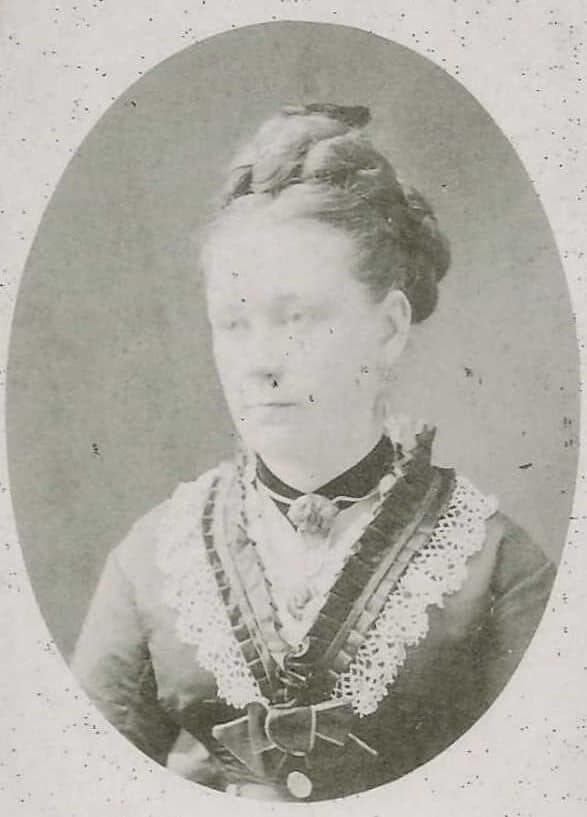
Charlton House
In 1860 Charlton Villa had been put up for sale.
In 1861 Eliza Marian (b. 1801), Henrietta (b. 1806), Mary J (b. 1816) & Joseph S (b. 1811) Pendergast were living at Charlton Villa.
Other than that the family – for they were siblings – were from Ireland and he was a Surgeon Major I have established nothing.
To let notices for Charlton Villa also appeared in the Bath Chronicle and Weekly Gazette on Thursday 18 September 1862 and Thursday 28 November 1867, inter alia.
By 1869 It was occupied by Peter Rooke (1794 – 1869) and his wife Georgiana Cottle Spender (1804 – 1885) who also appears in the 1871 and 1881 censuses. Georgiana’s father was splendidly named Onesiphorus – and was a plumber and glazier.
In 1861 they had been running a ladies school at Devonshire Buildings and 16 pupils are noted on the census.
In 1862 a ‘young rascal’ named Joseph Fry had been found guilty of stealing a saw and other items from his stables and was sentenced to 4 years penal servitude.
Penal servitude included hard labour as standard. Hard labour could be essentially useless such as a treadmill, crank or shot drill but sometimes might involve skills such as shoemaking, tailoring or joinery or public works.
By 1891 Francis Awdry Thring (1822 – 1897) and his wife Jane Henrietta Nantes (1812 – 1909) were at Charlton Villa.
He was the son of John Tivitoe Thring (1791 – 1851) – described as a scrivener – and Harriett Walker (1793 – 1857) and his grandfather had been Rev Dr Brouncker Thring (1752 – 1812).
His father had been made bankrupt by 1837, losing the considerable estates passed on to him. Francis was only 15. He became clerk & accountant at Devonport Dockyard and was living on a civil service pension in 1891.
His son Edmund John Henry Thring (1853 – 1912) who was a maths tutor at Monkton Combe School for many years advertised regularly in the Bath Chronicle as a mathematic tutor.
By the 1901 census Mary Shelford (née Deshon) (1857 – 1938) who was the daughter of Lt Gen Frederick George Thomas Deshon (1818 – 1913) CB who had married, as his second wife Julia Euphemia Elizabeth Tower (1839 – 1904), who was the niece of Jane Caroline Dewhurst (1806 – 1895), who lived at Glenburnie from 1869 – 1895, was living at Charlton Villa, now called ‘The Cottage’.
Her husband was Edward John Shelford (1853 – 1930), who appears in the 1911 census, where he gives his occupation as ‘Pensioned East India Merchant Now’.
Overland
Rutland Villa was not built until after 1871 as the land it was built on was not auctioned until the end of that year – it had been in use as a kitchen garden occupied by a William Wale who was a butcher.
It was soon occupied by Andrew Shepherd (1817 – 1904) and his wife Rebecca Hanney (1818 – 1891) whom we have previously seen at 115 Church Road from 1871 to 1877.
Andrew Shepherd lived at Rutland Cottage until he died. Since researching him for when he lived at 115 Church Road I have established that his father was Swithen Shepherd (1782 – 1859) who was a ‘victualler’ and owned or part owned the Rising Sun in Grove Street, the Sedan Chair in Bridewell Lane as well as 2, 3, 4, 5 and 10 Summerlays Place and 1 & 2 Mount Pleasant in Snow Hill.[2]
By 1911 William Henry Clark (1850 – 1922) was living at Rutland Cottage. He was Chairman of Bath Rural District Council and had farmed 800 acres on the Foxcroft estate of Hinton House.[3]
Glenburnie
Alma Villa was built for Thomas Cruttwell (1808 – 1881), the son of Thomas Macaulay Cruttwell (1777 – 1848) and Mary Micklem (1786 – 1849). It was probably named for the Battle of Alma in the Crimean War.
Before moving to Alma Villa Thomas Cruttwell lived at Corsham and left there in 1856 – presumably to move into Alma Villa.
He was a solicitor, like his father and became, in 1851 Clerk to the City of Bath Act 1851.
During the 17th and 18th centuries, the provision of amenities such as paved streets, street lighting, and policing became more urgent.
Bath Corporation did not have the authority to do this work or to raise money to fund it and so obtained private Acts of Parliament to enable them to carry out specific functions. Acts obtained in 1707, 1721 and 1739 gave them powers to set up a turnpike trust and to pave, clean and light city streets, and to arrange rubbish removal, for which they could charge a rate on householders.
These Acts, and an Act of 1757 which sought to make parishes responsible for such services, had limited success, and Bath Corporation set up Commissions for specific purposes. Such commissions were set up in Bath by Acts of Parliament in 1766, 1789, 1793 and 1801.
Although the Corporation was represented on the Commissions, they were independent bodies. Thomas Macaulay Cruttwell and Thomas Cruttwell, as significant citizens and solicitors had served on these.

The Commissions came to end in 1851, when their functions were taken over by the Council under the Bath Act 1851.
Under this Bath Corporation adopted the provisions of the Public Health Act of 1848 and became the Local Board of Health for the city; this gave it powers and responsibilities in relation to public health and sanitation, the provision of sewers, paving and cleaning of streets and removal of rubbish. The Act repealed all the Acts relating to Commissions, and provided that all the assets of the Commissioners were to be passed to Bath Corporation.
It appointed a committee for executing the Act and Thomas Cruttwell was appointed Clerk to the committee. This committee came to an end in 1871, when its responsibilities were passed to Bath Corporation as the Local Government Board came in.
As well as working with Bath Corporation Thomas Cruttwell had private work such as conveyancing – as can be seen on the deed for our house and the advert for his work earlier for Philip Bennet (1771 – 1853) who, although he had sold Widcombe Manor many years before, and moved to Rougham Hall, a large mansion (now completely derelict) in the Tudor and Gothic styles, near Bury St Edmunds, built for him in 1830 to replace the 1690 building, still had much land around Bath.
It seems the work that he did for Philip Bennet was on the Tithes Conmmutation Act 1836 which replaced the ancient system of payment of tithes in kind (crops, eggs, cattle, timber, fish, etc.) with monetary payments.
Thomas Cruttwell married Mary Wilson (1810 – 1842) and had at least 3 children. Isabella Elizabeth (1840 – 1841), John Wilson (1842 – 1850) and Mary Jane (1838 – 1866). She married Cornelius Lloyds (1820 – 1879) with whom Thomas Cruttwell was in partnership for a time.
This partnership was dissolved in 1868[4] – perhaps the death of his only surviving child was ‘the last straw’. In any case Alma Villa was put up for sale[5] and Thomas Cruttwell moved to Newbury where he died in 1881.

The new owner was a spinster named Jane Caroline Dewhurst (1806 – 1895). Her father Edward Dewhurst (1767 – 1843) and her mother Elizabeth Markoe Heyliger (1779 – 1848), who was Danish, had estates in St Croix. She lived at Alma Villa from 1868 to 1895 ‘living on her own means’.
In 1875 her niece Julia Euphemia Elizabeth Tower (1839 – 1904) married Lt Gen Frederick George Thomas Deshon (1818 – 1913) CB and the wedding breakfast was held at Alma Villa.
By 1901 Alma Villa was occupied by Thomas Robert Green Ashman (1852 – 1919) and his wife Mary Agnes Bisdee (1857 – 1926). He had been born Thomas Robert Green and was the son of James Ashman Green who was an owner of Holcombe Brewery. He changed his name due to the terms of a will from an uncle. His wife was a member of the Bisdee family who owned Hutton Court.[6]
By 1908 Alma Villa, renamed to Glenburnie was occupied by Edward Dudley (1847 – 1922). He had been married to Ethel Chanter (1848 – 1901).
In 1908 his daughter Ethel Alice Mary Chanter Dudley (1875 – 1948) married Harry Sangster Rivington (1874 – 1931) the son of Capt George Rivington RN (1833 – 1913) who lived at Combe Villa (now Scott House).[7] Interestingly his daughter Nellie Sangster Rivington (1873 – 1927) had married Rev Sawrey Brownlow Benson (1861 – 1918), who was Vicar of Combe Down from 1897 – 1902, in 1898.
When Edward Dudley died in 1922 Glenburnie was acquired by Monkton Combe Junior School as a dormitory for 20 boys and was then extended. In 2016, with the relocation of the pre prep to new premises by the main junior school buildings Glenburnie is being reconverted into a private residence.


